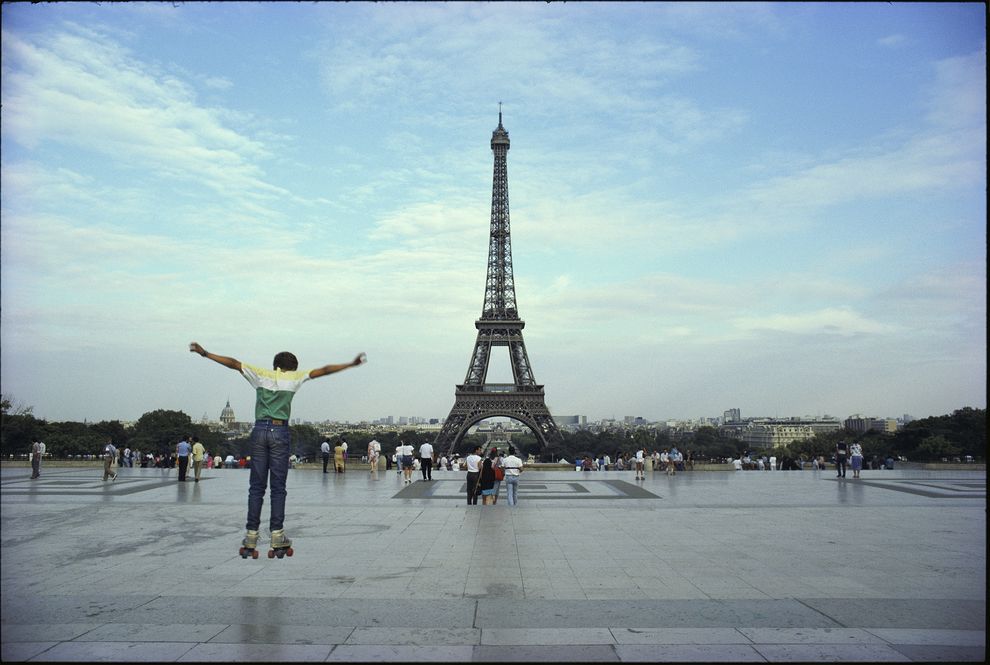Gustave Eiffel was an unromantic man who designed the most romantic structure in Paris.
A skater soars across the pavement of the Trocadero in Paris, June 1985.
When you read biographies of Alexandre Gustave Eiffel and his famous tower, which turned 125 yesterday, you're struck at first by a paradox: How did something so daring, so beautiful, so outrageous—in 1889 it outraged many—come to be built by such a colorless little dweeb?
Eiffel himself provided at least part of the answer: His tower, he said, was dictated by the wind.
There was not a drop of romance in the man. Countless newlyweds have made honeymoon memories standing at the top of his 300-meter (1,000-foot) tower, gazing out at the City of Light, and staring into the little office where, in later years, after he'd been forced to stop building things, Eiffel passed the time making meteorological observations.
He himself was luckless in love. After six failed courtships, he finally demanded that his mother find him a suitable bride; by that he meant "a good housekeeper who will not pester me too much, who will cheat on me as little as possible, and who will give me fine healthy children that will in fact be mine." There's plenty of material for a psychiatrist in that statement, especially given the shape of Gustave's masterpiece, but not much romance.
The ne plus ultra of Parisian icons is surely the Eiffel Tower, seen here in September 1914.
A businessman and an engineer to the marrow, Eiffel had already made his name as a builder of soaring railway bridges and railway stations when the organizers of the Paris Universal Exposition of 1889 came looking for a monument to dominate the Champ de Mars.
An assistant of Eiffel's did a rough sketch—Eiffel was terrible at drawing. The sketch showed a tower that looked pretty much like a pylon on a railway viaduct, or maybe an oil derrick. After that the wind took over.
The goal, specified in Eiffel's contract, was to build the tallest structure ever, at 300 meters (1,000 feet) high. The challenge was to keep the wind from knocking it down. After all, in 1879 a gale had toppled a railway bridge in Scotland, plunging a train and 75 passengers into the Firth of Tay.
With the Eiffel Tower as backdrop, children sail toy boats in a pond in July 1936.
Eiffel's solution was twofold. First, the lacy trusswork of his tower would give the wind nothing to push. The Eiffel Tower is, in a manner of speaking, lighter than air: All that wrought iron weighs less than the column of air that surrounds it. And second, the tower's curving, tapering structure would channel the load of the wind and the weight of the tower safely to the ground.
"Before coming together at the high pinnacle," Eiffel wrote, "the uprights appear to burst out of the ground, and in a way to be shaped by the action of the wind."
The Eiffel Tower, seen here in December 1946, was completed in 1889 for the Universal Exposition.
In other words, the tower's beauty emerged from engineering calculations. It was a new kind of beauty in the world, the forerunner of the modernist dictum that "form follows function," and in 1889, the Paris intelligentsia were scandalized by it.
Guy de Maupassant, the famous short-story writer, later said he'd been forced to leave France, the tower irritated him so much.
 The Seine slips beneath the Pont Grenelle near the Eiffel Tower, shown here in July 1936.
The Seine slips beneath the Pont Grenelle near the Eiffel Tower, shown here in July 1936.
In its first decades the tower, which had been built as a temporary feature of the Universal Exposition, only narrowly escaped being demolished. Even today, when you turn a corner in Paris and the tower soars into view, it remains startling—that is, fresh. And Paris is inconceivable without it.
The gate of the Trocadero frames the Eiffel Tower in a July 1921 photograph.
Long after the great Gustave died, bored and a little bitter, the architect Le Corbusier paid homage: "I bring to the Tower the testimony of a tireless pilgrim across the world. In the cities, in the savanna, in the pampas, in the desert, on the Ghats and on the estuaries, everywhere, among the humble and among the others, the Tower is in the heart of everyone, symbol of a beloved Paris, beloved symbol of Paris."






